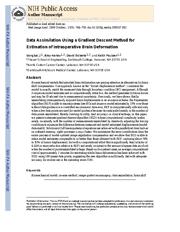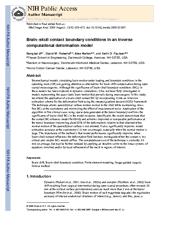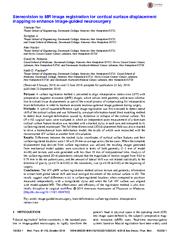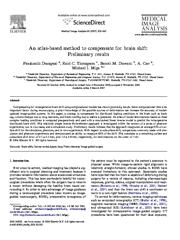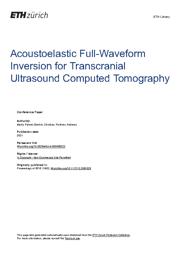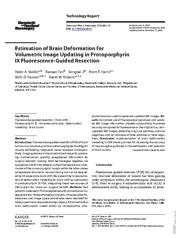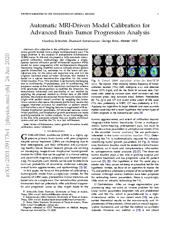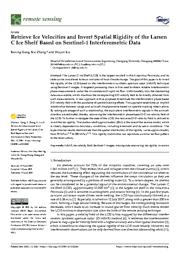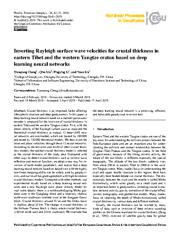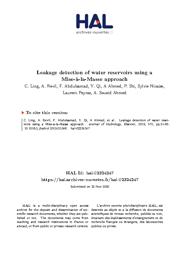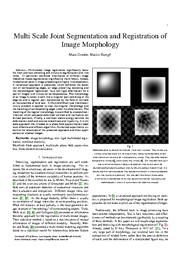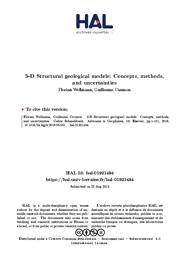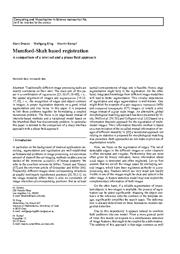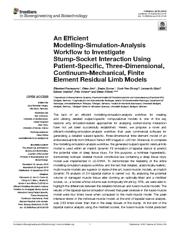A copy of this work was available on the public web and has been preserved in the Wayback Machine. The capture dates from 2019; you can also visit the original URL.
The file type is application/pdf.
Filters
Data assimilation using a gradient descent method for estimation of intraoperative brain deformation
2009
Medical Image Analysis
Biomechanical models that simulate brain deformation are gaining attention as alternatives for brain shift compensation. ...
Previously, we have shown that by assimilating intraoperatively acquired brain displacements in an inversion scheme, the Representer algorithm (REP) is able to maintain stress-free BCs and improve model ...
Andrea Borsic at the Dartmouth College for helpful discussion on utilizing the PARDISO software package. ...
doi:10.1016/j.media.2009.07.002
pmid:19647473
pmcid:PMC2749709
fatcat:ecgheft32rfmjpsrt4hkhlbxf4
Brain–skull contact boundary conditions in an inverse computational deformation model
2009
Medical Image Analysis
In this study, we extend the application of a brain-skull contact BC by incorporating it into an inversion estimation scheme for the deformation field using the steepest gradient descent (SGD) framework ...
The importance of the method is that model performance significantly improves when brain-skull contact influences the deformation field but does not degrade when the contact is less critical and simpler ...
Conclusion We have incorporated a brain-skull contact BC within a computationally efficient inverse method for intraoperative data assimilation. ...
doi:10.1016/j.media.2009.05.007
pmid:19560393
pmcid:PMC2893576
fatcat:ba5bk4jte5f4teiw4kc3dfrkxi
Stereovision to MR image registration for cortical surface displacement mapping to enhance image-guided neurosurgery
2014
Medical Physics (Lancaster)
The full three-dimensional (3D) displacement field was also extracted to drive a biomechanical brain deformation model, the results of which were reconciled with the reconstructed iSV surface as another ...
extract tissue displacements as part of the overall process of compensating for intraoperative brain deformation in order to maintain accurate neuronavigational image guidance during surgery. ...
process through data inversion (e.g., to minimize model-data misfit 9, 10 ) . ...
doi:10.1118/1.4894705
pmid:25281972
pmcid:PMC5176089
fatcat:af2j4rm3t5cynd7rudqtlckjey
An atlas-based method to compensate for brain shift: Preliminary results
2007
Medical Image Analysis
An atlas of model deformations based on these complex loading conditions is computed preoperatively and used with a constrained linear inverse model to predict the intraoperative distributed brain shift ...
This translates to a remaining surface and subsurface shift error of 0.7 ± 0.3 mm, and 1.0 ± 0.4 mm, respectively, for deformations on the order of 1 cm. ...
The authors would also like to thank the PETSc maintenance staff for their assistance with the parallelization of the computational model. ...
doi:10.1016/j.media.2006.11.002
pmid:17336133
pmcid:PMC3819812
fatcat:baeyx5zrwra7hnhakt7tgcwqmm
Acoustoelastic full-waveform inversion for transcranial ultrasound computed tomography
2021
Medical Imaging 2021: Ultrasonic Imaging and Tomography
Applying full-waveform inversion to a set of synthetically generated acoustoelastic forward data allows for favorable reconstructions to be achieved when considering an acoustoelastic prior model of the ...
Using the spectral-element method on cubical meshes, we obtain a scalable and performant method to resolve such a coupled physical system. ...
This in silico study analyzes the use of acoustoelastic FWI in conjunction with the spectral-element method (SEM) for reconstructing a 2D model of the brain. ...
doi:10.1117/12.2581029
fatcat:ufhuo3ebhzemvnmoqgxnkdpw7i
Estimation of Brain Deformation for Volumetric Image Updating in Protoporphyrin IX Fluorescence-Guided Resection
2010
Stereotactic and Functional Neurosurgery
Conclusion: Implementation of brain deformation modeling in FGR shows promise for increasing the accuracy of neurosurgical guidance in the delineation and resection of brain tumors. ...
Roberts serves on the data monitoring committee for a Medtronic deep brain stimulation study. ...
., USA) for the supply of ALA, and the use of the OPMI Pentero surgical microscope, StealthStation Treon navigation system, and iU22 3D ultrasound system, respectively.
Conflict of Interest Dr. ...
doi:10.1159/000258143
pmid:19907205
pmcid:PMC2813794
fatcat:epjqftukjrcibp3osceseqdxry
Automatic MRI-Driven Model Calibration for Advanced Brain Tumor Progression Analysis
[article]
2020
arXiv
pre-print
To this end, we present a fully automatic tumor-growth calibration methodology that integrates a single-species reaction-diffusion partial differential equation (PDE) model for tumor progression with multiparametric ...
We propose a coarse-to-fine multi-resolution continuation scheme with parameter decomposition to stabilize the inversion. ...
Acknowledgment The authors would like to thank Naveen Himthani and Andreas Mang for their valuable contributions and the fruitful discussions. ...
arXiv:2001.09173v1
fatcat:z32lro6tabaqpozofdcog35ba4
Retrieve Ice Velocities and Invert Spatial Rigidity of the Larsen C Ice Shelf Based on Sentinel-1 Interferometric Data
2021
Remote Sensing
The shallow-shelf approximation (SSA) is the core of the reverse model, which is closely dependent on boundary conditions, including kinematic and dynamic conditions. ...
This rigidity distribution can reproduce a similar ice flow pattern to the observations. ...
Acknowledgments: The authors are very grateful to the European Space Agency for providing Sentinel-1 data. ...
doi:10.3390/rs13122361
fatcat:ppc7v3ir4vfvjlhoaqv2gtt65u
Inverting Rayleigh surface wave velocities for crustal thickness in eastern Tibet and the western Yangtze craton based on deep learning neural networks
2019
Nonlinear Processes in Geophysics
Compared with other ways to detect crustal thickness such as seismic wave reflection and receiver function, we adopt a new way for inversion of earth model parameters, and realize that a deep learning ...
In this paper, a deep learning neural network based on a stacked sparse auto-encoder is proposed for the inversion of crustal thickness in eastern Tibet and the western Yangtze craton. ...
The authors are grateful to Xie Jiayi for providing the phase velocity maps, Shapiro Nikolai for making model CUB2 available, Gabi Laske for making model CRUST1.0 available, and Zhu Jieshou for making ...
doi:10.5194/npg-26-61-2019
fatcat:huncfr57z5gulasg57fsy7ccwa
Leakage detection of water reservoirs using a Mise-à-la-Masse approach
2019
Journal of Hydrology
We test a new approach for the inversion of the voltage data using sandbox experiments and numerical modeling. ...
For a leak having the form of a crack, the inversion results using the source compaction method agree with the position of the leak and its shape. ...
The postdoc of Abdellahi Soueid Ahmed is funded by EDF through a contract with the CNRS. We thank the two referees for their very useful review of our manuscript.
Appendix A. ...
doi:10.1016/j.jhydrol.2019.02.046
fatcat:vc2z4chf5jh4jko3rhqggfa2tq
Multiscale Joint Segmentation and Registration of Image Morphology
2007
IEEE Transactions on Pattern Analysis and Machine Intelligence
A variational approach is presented, which combines the detection of corresponding edges, an edge preserving denoising and the morphological registration via a non-rigid deformation for a pair of images ...
The matching of the regular morphology is quantified by a second contribution which compares deformed normals and normals at deformed positions. ...
Furthermore, we thank Carlo Schaller from the Department of Neurosurgery, Bonn for discussions on medical morphology as well as Benjamin Berkels for support with the volume renderer. ...
doi:10.1109/tpami.2007.1120
pmid:17934227
fatcat:4nxgvulhorahvb2gpruu7j2m2e
3-D Structural geological models: Concepts, methods, and uncertainties
[chapter]
2018
Advances in Geophysics
We introduce a formulation for geological model representation and interpolation and uncertainty analysis methods with the aim to clarify similarities and differences in the diverse set of approaches that ...
We believe that some reasons for this omission are (a) an incomplete picture of available geological modeling methods, and (b) the problem of the perceived static picture of an inflexible geological representation ...
This type of method could certainly be extended to deform a reference model volumetrically. ...
doi:10.1016/bs.agph.2018.09.001
fatcat:drmjlawqy5c5rhotprbh7hlfv4
Analytic expression of fluorescence ratio detection correlates with depth in multi-spectral sub-surface imaging
2011
Physics in Medicine and Biology
Here we derived analytical solutions to diffuse light transport in biological tissue based on spectral deformation of diffused near-infrared measurements. ...
We present experimental measurements acquired with a broad-beam non-contact multi-spectral fluorescence imaging system using a hemoglobin-containing diffusive phantom. ...
Light Transport Modeling Methods
Relationship between fluorescence ratio and depth Figure 1(a) illustrates an example of a non-contact configuration for intra-operative multispectral imaging. ...
doi:10.1088/0031-9155/56/21/005
pmid:21971201
pmcid:PMC4959601
fatcat:ugaahqw75zftrebsv4meksh7ja
Mumford–Shah based registration: a comparison of a level set and a phase field approach
2008
Computing and Visualization in Science
The focus is on edge-based instead of intensity-based methods and a variational model based on the Mumford-Shah free discontinuity problem. ...
A proper registration depends on a good initial segmentation and vice versa. In this paper it is proposed to link these problems together by formulating a coupled variational problem. ...
The initial idea for this approach has emerged during the IPAM Workshop on Inverse Problems, Sept. 2003. ...
doi:10.1007/s00791-008-0084-2
fatcat:eii5wtbspresff5hjmirogl77i
An Efficient Modelling-Simulation-Analysis Workflow to Investigate Stump-Socket Interaction Using Patient-Specific, Three-Dimensional, Continuum-Mechanical, Finite Element Residual Limb Models
2018
Frontiers in Bioengineering and Biotechnology
The proposed approach is not only limited to modelling residual limbs but also has applications in predicting the impact of plastic surgery, for detailed forward-dynamics simulations of normal musculoskeletal ...
that 7.65% of the residual limb volume was injured, while the detailed-model predicted 16.03%. ...
Constitutive Muscle Model A continuum body B is assumed to be a collection of points P in space whose local deformation can be described by the deformation gradient F. ...
doi:10.3389/fbioe.2018.00126
pmid:30283777
pmcid:PMC6156538
fatcat:el5ttk2np5gkdhup46ps5oywve
« Previous
Showing results 1 — 15 out of 300 results

